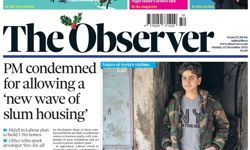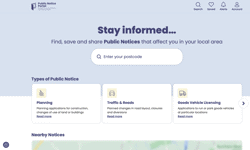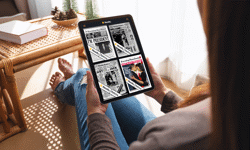The senior newspaper executive could scarcely be happier about the latest research from the Newspaper Marketing Agency (NMA) and its chief executive Maureen Duffy.
“I’d marry Maureen if I wasn’t married already,” joked the executive when asked what he thought of the latest NMA work that demonstrated comprehensively that, across a wide range of advertising categories, sustained marketing activity can, and has, pushed up newspaper advertising revenues against the market trend.
The NMA research, which tracked the link between effort and outcome over the six years it has been in business, is one of a number of unrelated studies in recent weeks that have provided, at least small chinks of light, in the overall mood of gloom that has been surrounding the industry.
They range from the paidContent:UK / Harris Interactive poll that suggested that print and online could work together financially in tandem despite recent appearances to the contrary, to the latest European Media Survey (EMS) survey that showed international print titles holding up surprisingly well in the recession – better even than television.
In the grander macroeconomic scheme of things, there are also growing signs that the worst of the advertising recession might just be over.
NMA research
The NMA has over the past six years conducted insight research in a total of nine categories which represent half of the UK’s £10 billion display advertising market.
In The NMA: Catalyst For Share and Revenue Growth, the organisation has managed to produce stark “before and after” contrasts to demonstrate its impact. Of course there is an inevitable element of self-justification here but the numbers do seem to speak for themselves.
In the categories with insight research, which range from retail and drink to finance and telecoms, newspaper display advertising revenue has risen from 11.6% of total expenditure before NMA intervention to 13.1% in the year to June 2009. Here national newspapers have apparently been winning share from both television and outdoor.
The NMA’s insight analysis goes beyond broad audience research and has bolstered category research with individual client’s advertising and sales performance. There has also often been collaboration on creative issues to try to improve the impact of the ads.
The nine categories produced £275 million in extra revenue over the six years measured on the “optimistic” assumption that the market would have remained unchanged during that time. In reality it would probably have gone down.
In categories without insight research such as computers, travel and transport and household equipment, the national newspaper share of display advertising fell from 19.9% to 14.8% over the same period – a total loss of £467 million.
“I think we have absolutely proved that when the papers put a robust and rigorous argument together of the value they can offer advertisers, it is well received and on the basis of that they are getting more revenue,” says Maureen Duffy.
“Therefore I think in terms of the future it’s optimistic. If they (the nationals) continue to prove the case they will continue to get revenue,” she added.
The newspaper industry’s relationship with Nestle provides powerful evidence of what has changed. As a result of detailed effectiveness tests for ads for the company’s pet foods, cereals and coffee products there was a significant rise in Nestle newspaper advertising. Many of the ads were part of brand campaigns as opposed to the more usual tactical efforts.
Over the year to May 2009, Nestle invested £7.2 million in national newspaper advertising, 11.9% of its total ad spend in the UK. This was five times the 2.3% share in 2003 and £5.8 million in extra revenue in the most recent 12 months.
At the same time, Coca-Cola has gone from 1.5% to 5.5%, a £1.37 million revenue difference.
With some companies, such as Kellogg’s, the difference is smaller but the cereal group has still increased its share of a UK advertising budget of £78.9 million from a 1.7% share to 2.5%.
In recent weeks, the NMA has also launched a marketing campaign of its own in the national press featuring copy lines such as “Expose Yourself to 23 million people tomorrow”, or using a tube made out of rolled up newspapers to suggest that the great thing about newspapers is that “they still work underground”.
“I think it (the campaign) is a great way of talking directly to many of our key customers who are senior clients, senior agency people and planners and telling them in a witty and engaging way the value that newspapers have to offer”, says Maureen Duffy.
EMS survey
From the painstaking and expensive promotional work of the Newspaper Marketing Agency to the results from this year’s EMS survey.
Shock horror: international print emerges rather well from the EMS summer survey after a few years of gentle decline and is definitely not dead at all. Indeed it seems, overall, to be coping better with the recession than television.
Publications as diverse as the Financial Times, the International Herald Tribune, USA Today and the Wall Street Journal have all held their readership steady compared with last year.
A small number including Metro in all its versions, Forbes Magazine and Euromoney have shown modest rises in readership.
The explanation seems to be that readers of international titles - particularly business dailies - have an even greater need than normal for reliable information in difficult times.
Mike Jeanes, international research director of Time & Fortune has emphasised that readership by top management is increasing for all global print brands.
“There is a simple explanation for this. Times are tough right now and senior executives and chief executives especially need information they can trust and information that gives them the confidence to make tough decisions”, Jeanes has argued.
The readers of international print titles are also particularly heavy users of the related online sites, something which gives an extra boost to the business.
PC:UK / Harris poll
International publications may have a great advantage compared to domestic, general newspapers in the current advertising environment, but there is potential hope for all, buried in the recent paidContent:UK / Harris Interactive poll.
At first appearance, it provides a little bit more familiar bleak news - that people are perfectly happy to use newspaper websites in their millions just so long as no-one asks them to pay for the privilege.
Only 5% of people who read an online newspaper site at least once a month said they would pay for online access.
That represents a pretty gloomy finding surely?
Except that when you throw in a free or discounted copy of the newspaper into the overall bargain, suddenly the 5% leaps to 48%.
Could this be the answer to the conundrum of newspaper finances? The printed edition might be used to leverage online subscriptions.
Andrew Freeman, Harris’ senior technology, media and telecoms consultant believes that the mixed model is “an interesting possible picture of the future.”
The value of such readers, engaged with content both online and in print, would be massively higher to advertisers, Freeman suggests, because they would be much more likely to be brand-loyal.
There has even been speculation that the much-vaunted online pay policy of News Corp chairman Rupert Murdoch may, in part, be designed to drive readers towards the print editions of papers like the Times.
After all, Murdoch continues to emphasise the importance of print to everything his company does.
As many researchers have found, including the Nieman Journalism Lab in the US earlier this year, more than 96% of newspaper reading is still being done with the print editions.
On the macroeconomic front, the latest IPA / BDO Bellwether survey may have found that marketing expenditure had fallen for the eighth consecutive quarter but it found the smallest reduction in budgets for more than a year.
There has also been a strong rebound in business confidence with 47% of companies surveyed seeing improved prospects.
Rory Sutherland, the IPA president, noted that the rise in confidence may have led to a rise in GDP in the third quarter.
“It will be interesting to see whether the rise in internet spend will presage an upturn in other categories,” Sutherland observed.
And then there is the dramatic issue of the Evening Standard going free.
Is that good news – after all there was an admission that the policy of charging 50p a copy for the paper had failed?
In the end, there was probably little choice. The run-rate of losses, it is believed, had reached £30 million a year and was clearly unsustainable.
The new business model for the Standard is potentially good news for the industry if the paper can sustain its existing editorial quality. At the moment the verdict has to be, so far so good.
Greater effort still has to be put into distribution. For instance, are loyal readers in the London suburbs going to be abandoned forever?
The big question is whether the Standard can earn enough advertising revenue from the newly expanded 600,000 distribution to cut the losses to at least manageable proportions.
So you can find good news for the newspaper industry if you look hard enough.
There is absolutely no need to dwell on the bad news for the industry - that’s all well enough known and obvious to everyone already.










